Hello! This is Yu Deguchi from CHITOSE GROUP.
It’s already December. This is the last Hottopics for this year.
I do not usually have an opportunity to use the lunar calendar, but only in December, I want to use the word “Shiwasu*”.
*December is called “shiwasu (師走)” in Japanese lunar calendar.
It may be because the character “run(走)” is accompanied by the feeling of busyness at the end of the year.
● Tavelmout Corporation was selected as a noteworthy startup
● We participated at the Open House of The Japanese Association in Singapore
● What is Chitose’s aim in “expanding the company”?
● We made a presentation on “Electrical microscope” at IEEE SENSORS 2018 held in India
● New series “Tomohiro Fujita’s Hisatsu-Shiwakenin” has started
● Tavelmout Corporation was selected as a noteworthy startup
I feel that Tavelmout has gained a lot of attention from the media. For example, Tavelmout was selected as a startup that will change the world in the December issue of Nikkei TRENDY. The Nikkei introduced Tavelmout as a startup developing a protein source, Yahoo!JAPAN FQ introduced Tavelmout as a remarkable food technology startup, and Tavelmout was selected for the BIOTECH category of “200 SUPERSTAR ENTREPRENEURS” in the January issue of Forbes Japan.
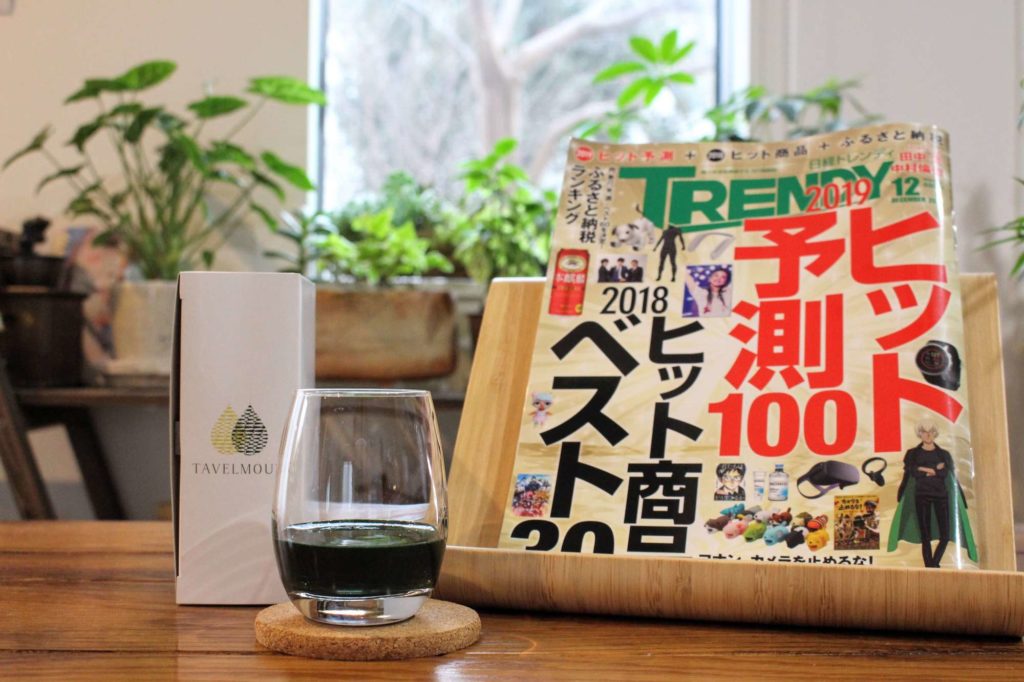
Also, Tavelmout was featured with the title “Algae and insects will save protein crisis” in the food category of the cover story, “What will happen in the future of Japan? Keywords & Calendar” of Nikkei TRENDY January issue.
▶Please refer to the web article at The Nikkei
Protein crisis gives emerging companies business opportunities. Insects and algae are used.
▶The article of Yahoo!JAPAN FQ is below
Will food technology save the world? Remarkable startups abroad and within Japan.
Tavelmout is often introduced as a protein source supply technology. We are now focusing on our goal to make Tavelmout a part of people’s lives as a healthy “ingredient” and establishing a production base in Brunei Darussalam.
▶Tavelmout representative Sasaki talked about the charm of Spirulina as a food ingredient.
Balanced food “Tavelmout” packed with over 60 kinds of nutrients.
Last month, I visited the Tavelmout factory, Kakegawa Bio Center, in Shizuoka prefecture. I have not been there in four years. I used to work for the project as a member of the business development division and visited Kakegawa frequently when I just joined the company in 2013. We had not named “Tavelmout” yet. It was very nostalgic and I was touched by the current appearance of the perfect facility.
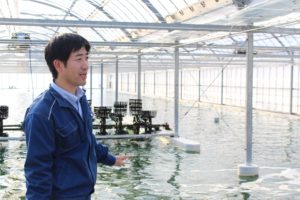
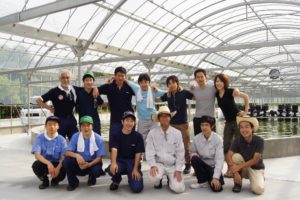
Only when I knew about the member’s activities and feelings, then I could do my job in “communicating”. The visit to Kakegawa was an opportunity to realize again that for me, feeling the atmosphere on the field is important and it is the source of my energy.
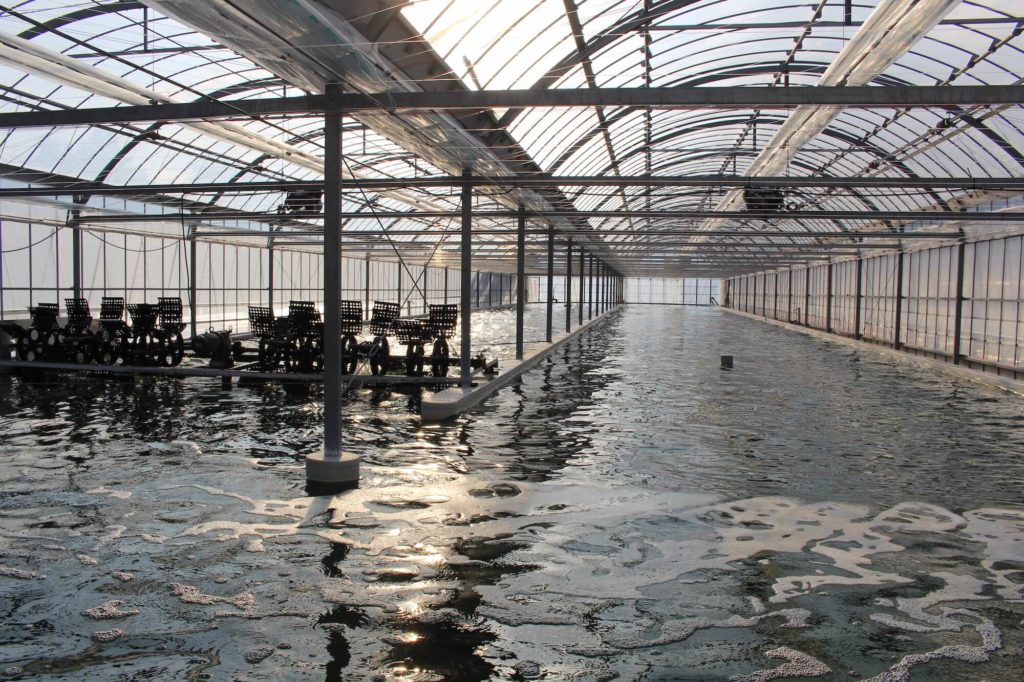
I tried fresh spirulina that I could only eat from there and went back home.
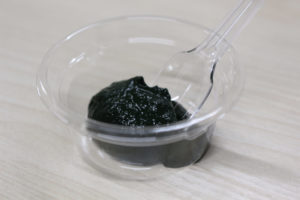
● We participated at the Open House of The Japanese Association in Singapore
The other day, we had a booth for Chitose Agriculture Initiative at the “Open House” of The Japanese Association in Singapore. It was the second time participating in the event following last year.
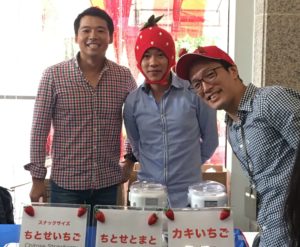
Well then, Ezan will report about the day’s events from Singapore!
◯Nur-Ezan Mohamed(Scientific Specialist, Business Development Division, Chitose Agriculture Initiative):
Chitose Agriculture Initiative (CAI) participated in the open house charity event organized by The Japanese Association, Singapore (JA) on the 24th November 2018. The event attracted more than 1,000 people, both Japanese expats and non-Japanese. This is the second time for me to join this event. It reminded me of my time in Japan; observing visitors walking around in their Yukatas while enjoying street food like Takoyaki and Yakisoba. There was even a live tuna cutting session.
Due to the popularity of our JA booth last year, CAI was invited again as a vendor for our Chitose strawberries and tomatoes from Cameron Highlands as well as kaki-ichigo(100% shaved frozen strawberries). We were excited to be able to promote CAI produce; explaining to them our ethical sustainable practices of farming and our unique harvesting method of picking strawberries and tomatoes only at their most ripen state. Many people are surprised that we are able to grow high quality and safe Japanese produce in Cameron Highlands, since in the recent years the area had received bad press for their heavy usage of pesticides and chemical fertilizers. Our kaki-ichigo was very popular with both the young and old. Everyone looked happy to indulge in healthy shaved dessert made from 100% frozen strawberries. It was a fascinating sight for me to see children dragging their parents to the booth to get them a cup as well as customers happily taking selfies with our kaki ichigo. As food waste is a huge problem globally, we were able to explain to our customers that our kaki ichigo is made from strawberries which could have gone to waste just because they are not pretty enough for the supermarket shelves.
We are pleased to have sold out everything during the event and donated part of the sales proceeds to charity organisations selected by JA. We look forward to participate again next year!
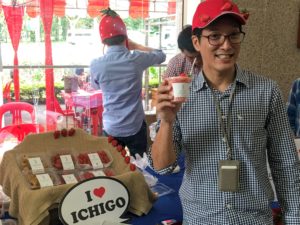
“Chitose Ichigo” and “Chitose Tomato” sold at the event are produced in Cameron Highland, Malaysia.
▶Malaysia made “Japanese Quality Strawberries” seek to build the future of agriculture in Asia
The other day, an article on strawberry production was published in the Malaysian newspaper “馬來西亞東方日報 Malaysia Oriental Daily News”. It seems to introduce the way to make the farm, the production methods and technologies to maintain high quality. I wrote “It seems” because the article was in mandarin. Google Translate helped me to roughly understand the article.
【农情】引进金马仑栽种 日本草莓香甜多汁
The strawberry artisan Kinoshita was interviewed at the farm. When I asked him about the background of what he was asked at the interview, he answered “The Japanese who produces strawberries in the mountains of Malaysia is like a panda.” Panda! (Adventure World in Nanki Shirahama but not Ueno zoo is best remembered by me as a zoo for seeing Panda.)
● What is Chitose’s aim in “expanding the company”?
WEB media Newswitch of The Nikkan Kogyo Shimbun posted about Chitose’s human resource development. What is Chitose’s aim in “expanding the compan”? How does Chitose achieve that?
▶Click below for the article.
If I say “You should do this”, the company will be doomed
Please read this article posted previously.
▶The unique bio venture “Chitose Bio”, their management method is “Collaboration with large companies” -A market capitalization of 10 billion yen in 15 years of establishment-
We appreciate all of Mr Matsuki’s great articles!
● We made a presentation on “Electrical microscope” at IEEE SENSORS 2018 held in India
Ogata from Nihon BioData Corporation gave a poster presentation at the conference ”IEEE SENSORS 2018” held in New Delhi, India at the end of October.
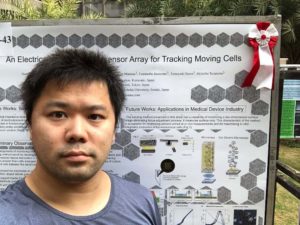
▶The paper submitted to IEEE is here. (*An electronic journal will be published at a later date.)
Norichika Ogata, et al., An Electrical Impedance Biosensor Array for Tracking Moving Cells, 2018 Conference Proceedings, IEEE Sensors Council, p.1557-1560, ISBN 978-1-5386-4707-3.
I have heard the word “semiconductors”, which is not very familiar to bioindustry, mentioned in the company for several years. Until recently, I have not known at all what he was doing, but he has been developing a new biosensor using semiconductor technology. He named it “Electrical microscope”.
▶Click below for press release announced together with Tohoku University.
Electrical microscope with autofocus and regeneration function to enable long-term tracking at the single cell level in vivo
“Electrical microscope” developed by Ogata is a biosensor for tracking cells that are moving in solution and can continuously measure the shape, size and movement of cells by utilizing electrochemical properties (electrical vibration).
Ogata is considering applications such as observing cells in the blood in real time using this sensor, and aims to use it as a human body imaging technique that will be in line with X-ray and endoscope.
※There are plans to develop this in a different entity from Nihon BioData.
◯Norichika Ogata (Representative, Nihon BioData Corporation):
Impressions of the conference
Since it was my first time participating in a conference for electrical and electronic engineers, and I did not have any acquaintances, I had to make opportunities to talk with other participants in order to make the conference more meaningful. In other words, letting people know about my research, think about scientific validity, point out mistakes or give a hypothesis to be verified. In addition to talking to other researchers at the welcome reception, I invented something to gain attention to my poster. It’s own poster award. Floral decoration is sometimes put on a student’s poster as a form of prize at academic conferences in Japan. I bought the decoration at a local stationery shop for 200 yen and put it on the top right of the poster. It was a success. My poster was reviewed by the four reviewers and 13 participants. It turned out that the validity of the scientific explanation regarding the electrical microscope was quite high, which was very meaningful. Now, we can develop the electrical microscope business with confidence. The conference venue was a very beautiful resort hotel and I was able to spend time at the sauna and play water polo at the swimming pool.
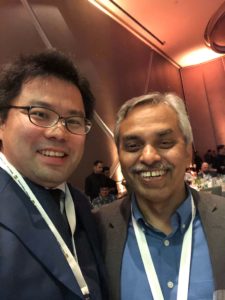
Preparation for the conference
After receiving notification of acceptance, I started to prepare for visa and vaccines. I applied and received the visa at the Indian Embassy in Kudanshita, so I used this opportunity to go to the Biryani restaurant near the Embassy and the National Museum of Modern Art, Tokyo. I could see the exhibition, ”Awakenings: Art in Society in Asia”. I recommend it if you are interested in the “student power movement” in Japan’s history. It opens until December 24. I received eleven injections for hepatitis A, hepatitis B, tetanus, Japanese encephalitis, rabies and typhus on both arms over two days. Afterwards I was able to prepare for the conference very smoothly until I got on the flight, but a person who was sitting next of me on the plane told me, “Your flight ticket is strange”. I was planning to simply transit at Shanghai and go to New Delhi, but actually there are two international airports in Shanghai and I had to move between these two airports although they are very far apart from each other. Because they could not speak English at the airport information desk, I checked the sign written in Chinese characters and tried to go to the other airport by taking the subway. The subway was easier than I thought, but I had three troubles. The first one was a limitation of transfer. Since some stations allow us to transfer by the transport card like Suica but not paper tickets, I had to get on and off a few times to change to the intended line. Secondly, I missed the first train because I had to queue up to wait for a baggage inspection at the ticket gate. That was long queue because the inspection started at a time just before the first train came. The third one was transferring. When the door of the train opened, both people getting on and off the train were standing at the front of the door and did not give way, so as soon as the door opened, they pushed against each other and I heard the roar. Next time, I want to ride a linear motor car. In India, I did not have any trouble, and enjoyed 16 yen spiced tea and 30 yen curry.

Experience of participation
It was my first time attending an academic meeting for electronics following the meeting for information science (* 1). In these fields, peer review by paper submission is carried out before the presentation at the conferences; we are unaccustomed these reviewed presentation style since it is not our specialty. We are foremost biologists and not confident in other scientific fields such as information science and electronics. It is an issue for us. Last year, a symbolic incident happened in the field of biotech start-up. A start-up came crashing down to earth due to a lack in scientific validity; Theranos, Elizabeth Holmes’s Silicon Valley biotech start-up had racked up a $9 billion valuation with its big vision to test for a number of conditions from just a small sample of blood. It was also taken up by Nature Biotechnology (* 2). The promotion of business development without any sharing of data to the scientific community and submitting the document on the premise of peer review are considered to be risks for both business operators and investors. Prior to that, we should eliminate the possibility that we might exaggerate their interpretations. Therefore, in order to clarify the scientific validity of the device we developed and the discovery based on it, we had submitted a paper to the conference presided by IEEE (Institute of Electrical and Electronic Engineers). After being reviewed by the four experts, we decided to gather challenges and issues to verify at the conference venue.
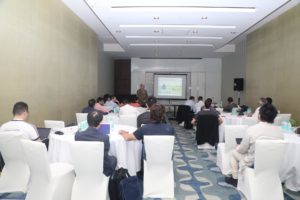
※1. ICIC2017, Liverpool, UK [Best Paper Award] https://doi.org/10.1007/978-3-319-63312-1_46
※2. After Theranos, Emily Waltz, nature biotechnology https://www.nature.com/articles/nbt.3761
● New series “Tomohiro Fujita’s Hissatsu-Shiwakenin” has started
In a business news medium, NewsInsight, Chitose Group representative Fujita started a new series. The title is “Tomohiro Fujita’s Hissatsu-Shiwakenin (Professional Journalist)”. That’s right. It’s spoofing Makoto Fujita*. Did you notice it…?
*Makoto Fujita was an actor for the TV series “Hissatsu Shiwazanin (Professional Assassin)”.
Investment for Japanese science and technology that are too selective and focused (JP only)
In addition, Chitose Group representative Fujita’s column, “If you start a business, you should not think that you’d be admired by someone!” was published as volume 3 of the series “The common values of the Japanese venture industry that should be reconsidered from the inside”.
https://journal.chitose-bio.com/start-a-business/
▶Please check out volume 1 and 2.
Volume 1: Does the venture industry use the “Death Valley” as an excuse?
Volume 2: How to create a business plan that gets the “Best Award”
When I saw Fujita writing such long sentences smoothly, I felt that he is surely someone who usually thinks about many different things. I hope you enjoy the articles as though you were getting inside Fujita’s mind.
Editor’s Postscript
About five years ago, I asked a senior student who was always tender and gentle, “Why do you think you can be good to people anytime?” Then, he answered, “Maybe I am very confident about myself.” I remember that the answer was very surprising and impressive to me at that time, but I understood very well.
I thought of this episode because I had a moment I felt as if I was losing modesty last month.
I thought that I lost my gentleness and modesty when I did not have enough time because I might not have the real confidence. The real modesty is based on the real self confidence. I feel that I have to keep trying to accumulate experience and results.
Surely, “The boughs that bear most hang lowest”.
